Story by Peter Welte
After two years of planning, Wilsonville’s South Metro Area Regional Transit (SMART) agency is finally ready to turn on their blinkers and drive their buses onto the shoulder. On Tuesday, SMART is hosting a kick-off celebration for the launch of their bus on shoulder (BOS) pilot project with the Oregon Department of Transportation (ODOT).
Starting in November, SMART will be pulling buses on their 2X line off to the side of ODOT’s I-5 freeway when traffic slows — in order to zoom past backed-up traffic along freshly repaved 12-foot wide shoulders.
ODOT deserves credit for thinking outside the lanes and doing something the former highway department has rarely (if ever?) done: help mass transit move faster than single occupancy vehicles. However, whether you bike, walk or bus, there are a few details in the margins which may be worth a closer look.
What’s in it for SMART?
Despite setting a goal for itself of having 92% of trips be “on time”, SMART’s 2X line was “on time” or early only about 74% of the time in October. ODOT believes this project will help give transit users a more reliable commute, and SMART anticipates an improvement in “on-time performance” from 74% to a range of 85%-90%. When the general traffic lanes drop below 35 mph, SMART’s buses will be allowed to take the shoulder and go up to 35 mph.
Improving reliability and demonstrating better “on time performance” could be one way SMART can stand out should it choose to apply for the kind of competitive federal funding that could help the agency buy more and bigger buses to meet demand (induced, hopefully, by SMART service improvements like this).
The more congested the freeway, the better it is to be riding the bus. According to A Guide for Implementing Bus On Shoulder (BOS) Systems (PDF). “Even a very short segment of BOS shoulder in a 5-mph traffic segment can yield substantial travel time savings,” that guide says. “For example, a quarter-mile segment with 5-mph speeds could save buses more than 2 minutes of running time.” And riders actually over-estimate how much time they save: “Passengers tend to perceive travel time benefits at two to three times the actual savings. Since perception directly influences mode choice decisions, even small savings can be important.”
So, more traffic should mean more riders, and skipping traffic means better “on time performance” which could mean more ability to grow operations (or at least scale back up; COVID cut the average weekday passenger trips in half for the 2X line).
What’s in it for transit riders?
Starting in November, SMART’s 2X line will have three solid selling points: Faster commutes, more predictable travel times, and on-board Wi-Fi. Plus, if all goes well, additional transit demand could lead to more buses, more often, as well as (possibly) additional routes.
What’s in it for people walking or biking?
Let’s get the obvious out of the way: If you walk or bike to the bus and there’s heavy traffic, you’ll have a few less minutes for doom-scrolling via the free Wi-Fi while the bus zips past traffic.
Despite myriad benefits, ODOT’s freeway shoulder bus operation will be no panacea. Driving buses down I-5’s shoulder could present unpredictable hazards such as debris, disabled vehicles, people biking or walking (remember: this is allowed on Oregon freeways in most places, including where ODOT’s pilot project is). We asked ODOT if they added additional lighting, as the “bus on shoulder” guide suggests for this context. They didn’t.
Also on the safety note, keep in mind that bus drivers won’t use the shoulder when visibility is poor, the bus will never be operated at more than 35 mph in the shoulder, and it can only go 15 mph faster than traffic. Hence, BOS is not exactly BRT (bus rapid transit) or anything close: if traffic is completely stopped, the bus speed is capped at 15 mph.
BikePortland reached out to public transit planning and policy consultant Jarrett Walker to ask: Could this be a first baby step toward BRT?
He wasn’t too optimistic:
“The premise of BOS is ‘Given that we’ve built this freeway as it is, and don’t have a bus lane, can we get some use out of the shoulder to get buses past traffic?’ It’s a kludge. It’s not BRT for all the reasons you can imagine. Shoulders are also for disabled vehicles and in some cases for bikes. Merges at every interchange are tricky, because motorists don’t expect a vehicle to be running along the shoulder. All those uses introduce a lot of uncertainty into the bus operations. But is it better than nothing? Sometimes, especially in the short term, and transit agencies often take what they can get.”
Authorized Use Only
ODOT provided BikePortland an image of the shoulder signage, however no one we spoke with – other than ODOT – thought the signage chosen (“Authorized Vehicles Only”) clearly communicates that the shoulder is still a designated space where people on bikes are expected and allowed.
Scott Kocher, a Portland-based safe transportation advocate and lawyer, was surprised when he saw it. “I’d want to see more signage alerting authorized drivers that there are pedestrians and bikes on the freeway shoulder.”
When asked to clarify, an ODOT spokesperson commented via email: “The authorized and priority uses of shoulders are: emergencies (and emergency vehicles), law enforcement vehicles, disabled vehicles, maintenance vehicles, bicycles and pedestrians. Transit must yield to all these priority uses.”
The signs (which are consistent with the standards outlined in the Manual of Uniform Traffic Control Devices (MUTCD) are used to inform motorists of the authorized use per state law. However, “bus on shoulder” operations are far from universal (only about a dozen states have implemented it), and the MUTCD does not appear to provide specific advice for appropriate signage. The sign ODOT selected is documented in the 2009 (most current) edition seems to speak more to “official” vehicles than the everyday Jane or Joe on a bike may think they are.
We looked around the country to see if there’s some established best practice. We hoped to find something in NACTO or MUTCD or AASHTO or one of the other TTWFOMLAs (“transport things with five-or-more letter acronyms”) but no luck. The state that pioneered “bus on shoulder” in 1991, and has around 300 miles of it, is Minnesota, and even their signage is confusing.
Google did turn up a sign that seems to be least confusing, below. (Minnesota road. Credit: Google Maps)
Still, ODOT insists it is clear, and safe: “… the operational requirement for buses to use this space is to yield to all other legal uses of shoulder. SMART’s bus operator training includes this topic.”
Share the Road
ODOT has been eying the shoulder for some time. Although SMART’s pilot is the first of its kind for an Oregon agency, C-TRAN was petitioning ODOT for access to the shoulders of Glenn Jackson (the bridge, not the man) years ago. Not long after that, in February 2019, TriMet applied for a $150,000 grant to study an express bus network which would “draw on ODOT’s existing analysis of the feasibility of Bus on Shoulder service”. Ultimately, TriMet’s report would find that a hypothetical evening-peak 12 mile trip from the I-205/I-5 interchange to Clackamas TC could save at most 3.5 minutes by using the shoulders. However, it also found that because people spend so much time waiting for buses or stopped at all the many stops they’re not disembarking at, simply adding frequent buses that stop less often would save a great deal of time too (e.g. 14 minutes on on Line 6, MLK Jr. Blvd).
Thus, those broad shoulders may look great to transit operators, but they aren’t the only way to get a better ride.
At the same time, sharing that space effectively preempts any chance of creating separated infrastructure for human powered transport. All the while technically complying with Oregon’s “Bike Bill”, which requires “accommodation” for people biking on any reconstructed facility; that’s exactly what ODOT has achieved by authorizing (through administrative rules) people to walk or bike on the shoulder.
Hau Hagedorn, chair of ODOT Oregon Bicycle and Pedestrian Advisory Committee (OBPAC), has spent much time thinking about how and when ODOT does or does not improve conditions for people biking on the freeway.
She’s concerned with projects like this or a shoulder expansion happening on I-205, ODOT is actually making conditions less safe for people cycling — and instead of acting in the spirit of the Bike Bill to properly accommodate people on bikes, ODOT could simply change their own rules to un-authorize people biking if conditions worsen. “People who bike and walk are allowed to do so on freeway shoulders unless ODOT prohibits it per the OAR. … The OAR allows ODOT to say that these sections are way too dangerous for people biking and walking.”
Get On The Bus
ODOT and SMART will host their pilot project kickoff event at Wilsonville Transit Center (9699 SW Barber St.) on Tuesday, Oct 26, from 12:00 to 1:00 pm. Speakers include ODOT Director Kris Strickler, Wilsonville Mayor Julie Fitzgerald, Tualatin Mayor Frank Bubenik and others.
The pilot project will run for one year, and just like on their C-TRAN I-205 pilot, ODOT is collecting a variety of quantitative and qualitative data related to safety, general operations, impacts to infrastructure, and transit performance. SMART, for their part, has trained their drivers in the classroom, and on the road, and says they put safety as their primary concern.
If all goes well, perhaps both SMART and ODOT will realize the full potential that’s possible when massive-occupancy public vehicles are allowed to properly compete with single-occupancy private vehicles. If so, perhaps they’ll see the merit in converting one of the slow lanes to a true bus rapid transit lane.
But if not, there’s always the trusty bike or e-bike, which can usually do more than 15 mph when traffic is at a standstill.
— Peter Welte
— Get our headlines delivered to your inbox.
— Support this independent community media outlet with a one-time contribution or monthly subscription.


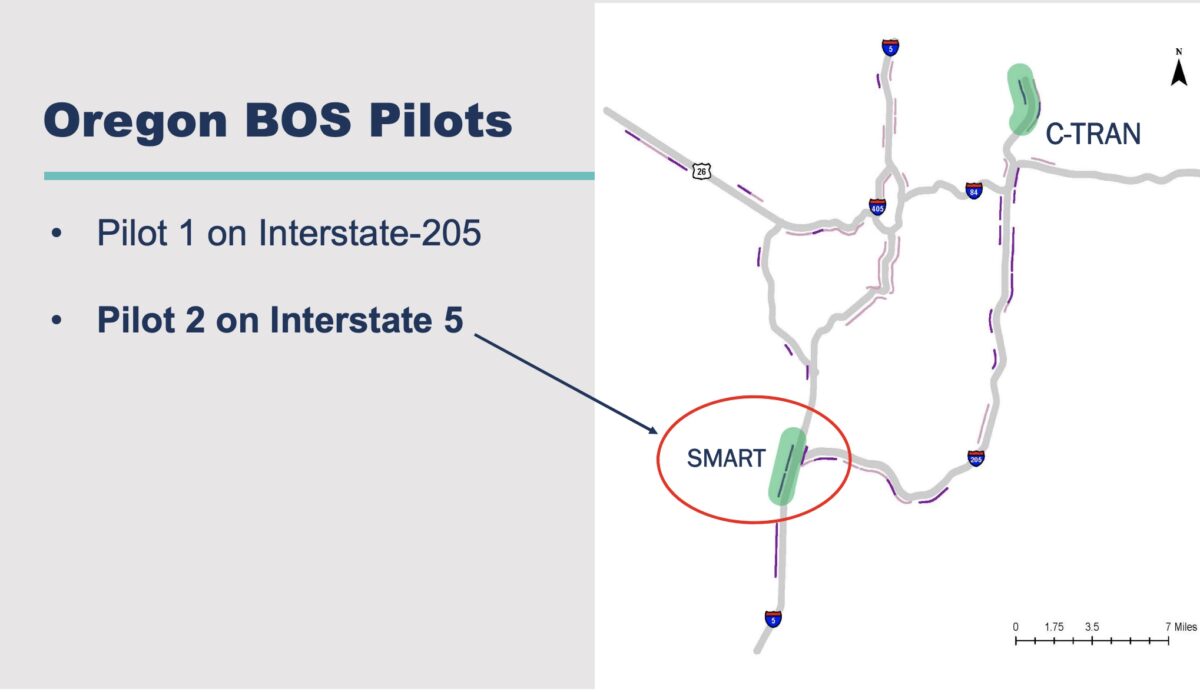
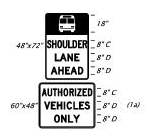
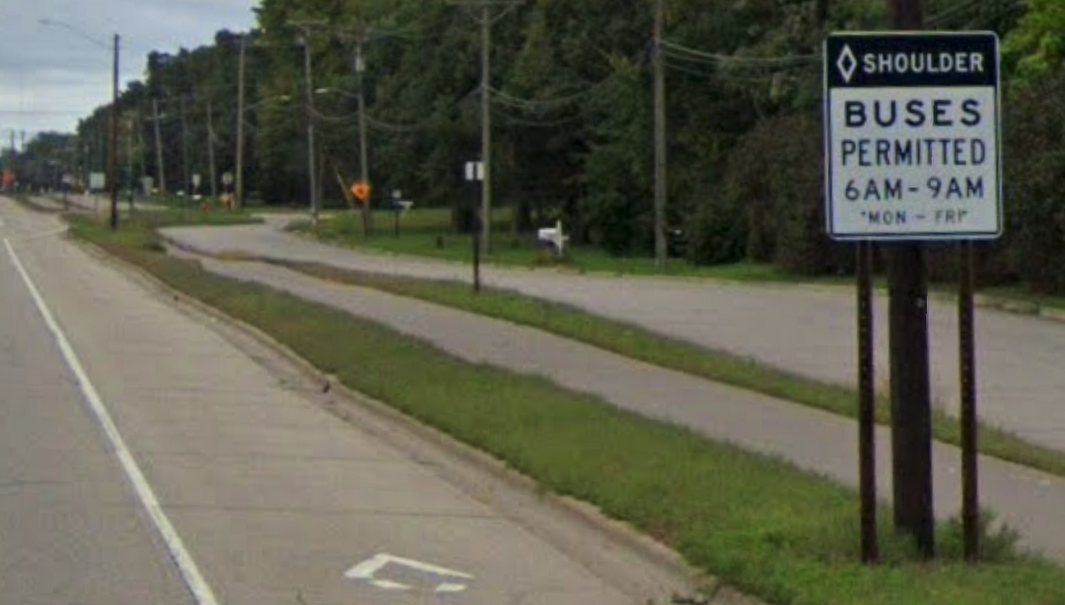
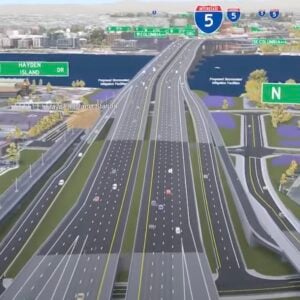
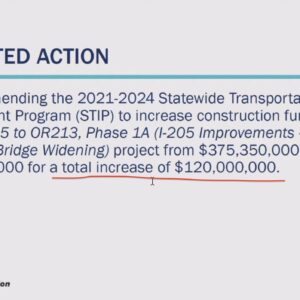

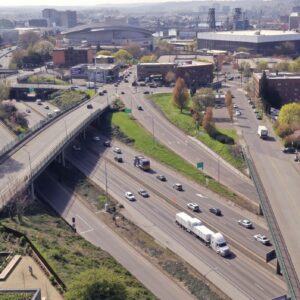
Thanks for reading.
BikePortland has served this community with independent community journalism since 2005. We rely on subscriptions from readers like you to survive. Your financial support is vital in keeping this valuable resource alive and well.
Please subscribe today to strengthen and expand our work.
This is incompatible with the rumble strips ODOT is installing on Freeway shoulders throughout the Metro area. Also, it is hazardous to cyclists using the Freeway shoulders where it is legal, e.g. west of Jefferson Street Exit on Highway 26.
They’re installing them all over Oregon. They are coming ubiquitous (and annoying) for bicyclists on some of our rural highways. They inhibit riding side by side and, if you hit them accidentally, they can take you down. That said, I like the fact that they warn drivers when they start to wander. It encourages sloppy drivers to stay in their lane.
There are two spacings for the mumble strips, one of them is compatible with Bus on Shoulder operation.
so they design ‘mumble’ strips to stop errant drivers from leaving the road and hurting themselves, and you can operate a bus on them but not a bicycle; that right there says a whole lot about bureaucratic priorities in the early 21st century.
Another option to consider, between full BRT and bus on shoulder, is to implement a “managed lane” on a freeway segment. The idea is to use congestion pricing along with vehicle-type restrictions (e.g. high occupancy vehicles are free or pay a lower toll) to keep the lane free-flowing. Buses in a managed lane should be able to make express trips more safely and reliably than buses on shoulder. The lane should be toll-free and unrestricted during uncongested times, and it probably works best with a three-lane freeway. If ODOT is going to add a third lane, or the freeway is already three lanes, this should generally be the goal, not bus on shoulder.
This will also work on two-lane freeway segments if both lanes are managed with congestion pricing to keep them free-flowing, and of course one can manage all three lanes of a wider freeway in a similar fashion.
Jonathan – Thanks for including the impact on bicyclist use of the shoulders. In the past, I often biked along WSDoTs shoulders – where legal – for commuting (SR-500) or touring (SR-14) if parallel routes are poor or fragmented.
We do need some language [both in the OR & WA administrative codes] that permits a bus operator to pick up a cyclist on the shoulder…if the very act of the frequent bus use causes the cyclist to reconsider using th shoulder for riding.
Thanks Todd. But I didn’t write that. Peter Welte did!
Sorry Peter!
As someone who used to regularly ride freeway shoulders and who particularly dislikes riding near buses, I think this is reasonable idea.
Having massive amounts of pavement that is barely used is a waste of money and bad for the environment. This is a positive step towards making public transit a more viable option is much better than separated cycling infrastructure to be taken over by camps — the end result being that neither the road nor the supposed infrastructure can be ridden.
I see no safety concerns. Riding freeway shoulders is no joke. While most of it isn’t that bad, ramps require a heightened level of vigilance and the interchanges can be awful, I-5/I-205 being a particularly gnarly one.
In any case, this won’t affect hardly anyone and it’s no biggie for anyone that it would. In all the time I rode, I never encountered another cyclist. Anyone who can handle the on and off ramps with traffic blasting by at 75mph really isn’t going to care about the rare bus plodding along at cycling speeds (except maybe as an impediment in the way) — 15mph is no fun if you have a long way to go.
Oh wow! I consider myself pretty brave on a bike, but I just can’t imagine riding on the shoulder of I-5, especially at an onramp with cars doing 75 mph. That’s just absolutely terrifying to imagine.
It’s really not that bad. I’ve done the entire legal section between Portland and Eugene a number of times, though I don’t have plans to do it again. Overall, I don’t think it’s particularly dangerous because you know where threats are coming from, sight lines are fantastic, and it’s easy to monitor.
You can go up to the exit at 291 or so, but I strongly recommend against going past Wilsonville headed north even though it saves a lot of time — the I-205 interchange is very difficult if traffic is fast and heavy (having said that, it’s outright fun if it’s gummed up). Headed south is much easier, but still not for the faint of heart.
Highway riding can be fun if you can come to terms with the noise and debris — you can get a really nice side draft off vehicles when it’s heavy and fast. I always go way up exit ramps before crossing so you absolutely know you can clear no matter how fast cars exit. On ramps are inherently easier since you know what’s coming and it’s just timing.
The worst part are construction zones because you sometimes lose your shoulder completely — learning in advance where these are is a really good idea to avoid unpleasant surprises.
For purposes of this article, I think supporting highway cyclists is a nonissue. Even if there were zero vehicles and it were only for bicycles, almost no one would ride. Normal people just aren’t able/willing to go any kind of distance in conditions.
The Boone bridge is the only option in the Portland metro area to ride across the Willamette River unless a person uses the Canby Ferry, rides to Oregon City, or goes over to Newberg. There are the floating bicycle options with the integrated trailer thing. I’ve rode on the Boone’s (Ferry) bridge, but I felt more comfortable on that in comparison to riding uphill (northbound) on SW Scholls Ferry Road between SW Beaverton-Hillsdale Highway and Sylvan.
do you really think the busses are going to stick to 15 MPH?!?!? IMO this would work best during peak times when the road is congested to the point of stop and go traffic, but if anyone uses the shoulder as a breakdown lane it will throw a huge monkey wrench into the concept. Also, I though transit was already allowed to use the HOV lane if one is present.
WashDOT & CTRAN have been testing bus on shoulder on SR14 for the last few years. They were planning on adding it to I205 up to the river this year but don’t know what the current status is.
I find it unbelievable that this article fails to mention that SMART is free. Only the route to Salem (1X) charges a fare. The line going on the freeway (2X) is free, as are all the other SMART bus lines, unlike TriMet or C-Trans.
https://www.ridesmart.com/transit/page/fares
Perhaps because it’s unimportant to the BOS concept proposed, and also because it’s nothing new – this has been the case for a while. It’s a commuter-oriented system (every 30 minutes for a couple lines during a couple parts of the day at best) that benefits from a relatively large payroll tax base. Historically it’s had more jobs than residents, and transit in Oregon is funded by employment, not residential land use. You may not understand that service frequency and travel time are more important than the cost of service, especially when it comes to luring people out of cars.
Eliminating the nominal transit fare would convert buses and trains into lounging spots for people with nowhere to go, undermining their core function: provide a safe and sustainable way for people to transit Portland.
This seems like something out of the Onion:
I was not aware that Oregon ever allowed bicycles or pedestrians on shoulders of the Interstate. In this case, at least the buses are limited to 35 mph. If traffic is completely stopped but shoulders are clear (seems rate) 15 mph seems like it could be a little higher.
It needs to be slow. There won’t be much clearance, and someone could pull over or open a door. 15mph will seem quite fast compared to standstill — and it is.
Bikes are allowed on most interstates in OR with a few specific exceptions carved out. The places that aren’t legal are so bad you really don’t want to try it. Frankly some of the legal places shouldn’t be, I-5 north of Wilsonville for example.
It will be interesting to see if the number of flat tires goes up.
Guaranteed. Maintenance of Oregon highways is pretty shaky, and, at least in Central Oregon, they sweep rural highways once per year, if that.
I spoke to the Director of SMART, and while I didn’t ask about flat tires, he did point out that SMART would be calling into ODOT when there’s debris in the shoulder. That makes sense to me and it’s good that SMART and people on bikes now have a shared interest to keep the shoulder clear.
Perhaps a good follow up in a few months would be – has ODOT swept this more often than other shoulders in order to support the BOS operations (and if so, how might they increase that maintenance where the other “BOS” is happening: bikes on shoulder).
I didn’t see any discussion surrounding what happens when a car needs to use the shoulder for a mechanical problem?
The bus would merge into the right lane to move around the obstruction and then return to the shoulder.
That’s right, according to ODOT’s press release:
> If a bus encounters an obstruction in the shoulder, the bus must merge back into travel lanes at least 1,000 feet before the obstruction or as soon as the obstruction is visible
The ‘or as soon as the obstruction is visible’ seems potentially concerning, but SMART’s Director did inform me that their drivers are being trained to stay off the shoulder in low-visibility situations (fog, etc). Now that I think about it again, it’s unclear whether or not this means the buses are only on the shoulders during daylight.
I never like designs where the “going straight” traffic is to the right of the “turning right traffic”. Especially not at highway speeds.
Bad for bikes, bad for buses.
That’s not how this will work. Dig a little deeper.
This post was already getting long (so, apologies for not making it clearer), but I did speak with the ODOT planner working on this, and he said the shoulder use isn’t continuous. Only about half the length of the pilot area is usable due to things like ramps (the bus merges back in before these stretches).
So it sounds like they’ve designed this to avoid car/bus weaving action.
That said, ODOT is also allegedly looking at bus-on-shoulder for the I-5 Rose Quarter area, and it sounds like they’re planning on putting the bus on the other shoulder (the inside one). I have no idea how that will work (if anyone knows who’s actually working on that project, let me know, because so far ODOT hasn’t been able to put me in touch with anyone).
Ask oneself, why is there not a carpool lane every inch of Portland’s freeways?
Or why is there not a toll lane on every inch of the freeways in the metro area?
Instead the Graham plan is to put buses on the breakdown lane were essentially there is now no safe place to pull over. Also the breakdown lane is full of debris which will lead to more damage the buses. It’s a half measure because of poor policy.
From ODOT’s press release: “the bus must merge back into travel lanes at least 1,000 feet before the obstruction [e.g. disabled vehicles or anyone in the shoulder] or as soon as the obstruction is visible”. That combined with the fact that they will only use the shoulder when there’s good visibility should help.